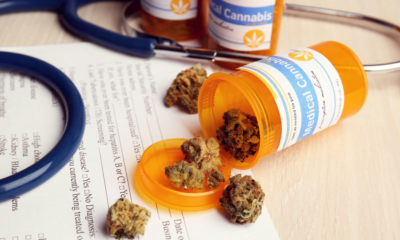Throughout Endometriosis Awareness Month, Cannabis Health spoke to people across the world living with the debilitating condition, about how access to cannabis helps relieve symptoms from chronic pain to anxiety.
Endometriosis, an extremely common inflammatory condition, is present in about one in 10 women and non-binary people, aged between 25 to 40 in the United Kingdom – but can affect people at any age.
It occurs when cells, similar to those lining the womb, grow elsewhere in the body, such as the bladder, ovaries, colon and rectum, and react to changing hormones in the menstrual cycle.
“They grow thicker in size as oestrogen levels peak in the middle of the cycle and then they break away and start to bleed like the lining of the womb during a period,” explains Dr Wendy Holden of Sapphire Medical Clinics.

“This blood is slowly reabsorbed by the body but the process can cause inflammation, pain, and the formation of scar tissue.”
Endometriosis can be difficult to diagnose due to its symptoms mirroring other conditions and the fact that it can only be officially diagnosed through a laparoscopy – a surgical procedure. The average diagnosis time from onset of symptoms is seven and a half years, with many patients being misdiagnosed or not being taken seriously.
Those who have the condition often suffer from painful periods, painful sex, pain in the lower abdomen, pain on passing a stool and urinating, or lower back pain. This can then lead to difficulty sleeping, inability to focus on daily tasks, and in some cases a mental health decline.
Managing chronic pain is the first line of treatment and can take the form of painkillers such as paracetamol, ibuprofen, mefenamic acid and opioids, or hormonal treatment, or both.
For some people, symptoms can be controlled at this stage, but for others surgery is the next option – however, it is only successful in around half of those cases with pain often reoccurring.
This is where medical cannabis comes in.
The plant was legalised to be prescribed by specialist medical consultants under regulations published in the UK in November 2018.
It is currently only available privately, for patients who have not experienced sufficient relief of symptoms from conventional treatments – however some experts believe that it could be effective prior to this stage.
The evidence
A 2019 study published in the Journal of Obstetrics Gynaecology Canada said one in eight Australian women with endometriosis uses cannabis to alleviate pain and other symptoms.
Researchers from NICM Health Research Institute, Western Sydney University and UNSW Sydney surveyed 484 Australian women with endometriosis between the ages of 18 and 45.
The participants rated the plant-based medicine as the most effective way to self-manage the disorder, above yoga, dietary changes and heat.
Along with reducing pain, the cannabis significantly reduced symptoms of nausea and vomiting, gastrointestinal symptoms, problems with their sleep, depression and anxiety.
Reported side effects were mild and relatively rare.
An Australian study published last November, reported that a high percentage of endometriosis patients found cannabis helped with their condition-related pain and improved their mood.
The 252 participants had legally obtained cannabis products that they used at home while reporting symptom changes over time on an app.
Researchers concluded that: “Cannabis appears to be effective for pelvic pain, gastrointestinal issues and mood, with effectiveness differing based on method of ingestion.
“Clinical trials investigating the tolerability and effectiveness of cannabis for endometriosis pain and associated symptoms are urgently required.”
Holly, 21, Western Australia
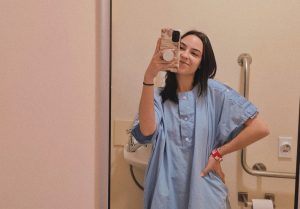
Holly first knew something was wrong at the age of 13 when her periods started and she began to bleed so heavily that a super tampon and overnight pad became quickly saturated.
Her GP prescribed her with an oral contraception pill which, she told Cannabis Health,“hid” the growth of her condition for the following eight years.
At the age of 20, she stopped taking the pill and numerous symptoms emerged including painful sex, severe cramps, chronic fatigue, heavy bleeding, IBS, incontinence and bloating.
In August last year she had a laparoscopy which resulted in a diagnosis of endometriosis on her uterus, bladder, bowel, pelvic side walls and elsewhere.
An attempt to remove the cells was unsuccessful and Holly’s symptoms worsened, so she is now seeking a specialist to perform another surgery to find some relief.
Along with traditional pain relief medication, Holly has tried a TENS machine, bath salts, herbal teas, pelvic floor therapy, physiotherapy, naturopathy, special diets and regular visits with mental health professionals.
But it was not until she discovered cannabis that she was able to see a dramatic reduction in her symptoms.
“I first turned to cannabis during a three-day flare that had me pinned to my bathroom floor for the majority of that time. I was wailing in pain, vomiting, shaking with no relief. I decided I had nothing to lose.”
She said a prescription to medical cannabis has helped her to regain a life she thought was stolen.
“I was able to socialise, manage my pain and finally sleep a full night with no painful wake up calls,” adding that it helped her to regain her appetite and eat without pain.
While she has experienced some opposing views on her choice of medication from friends and family, she said she has worked to move past that.
“It has allowed me to see life past pain and suffering. To appreciate the beauty of life around me and want to be a part of it all.”
Holly’s final thoughts?
I wish that people could be more understanding of just how debilitating this illness is and care enough to advocate for change.
I wish that for one day, us Endo-Warriors could wear our illness on the outsides of our body, maybe then there will be a greater urgency for change.
Kerry*, 25, UK

Kerry has always suffered from incredibly uncomfortable periods and from the age of 15 was forced to miss weeks of school due to the pain.
Unlike many sufferers, she was aware of endometriosis as her mother lived with it, and knew that it was likely she shared the condition.
When Kerry went to university, she approached her GP explaining her background, but it still took the entire duration of her course for her to get a diagnosis.
At the age of 21, she had a laparoscopy and was diagnosed with stage two endometriosis. She was prescribed a series of medications for the pain before a second surgery last June.
“As of next week, I’ll be nine months post op and I’m in the same amount of pain as I was before,” she told Cannabis Health.
The high levels of discomfort mean that she has to use a cane to get around, and often finds day to day tasks difficult.
Kerry was introduced to cannabis through her partner at university and noticed very quickly that it “really, really helped”.
“When I’m in pain, I usually don’t have an appetite, so it helps with that. But it is mostly for pain relief,” she said.
Kerry has experienced stigma from some members of her family around her use of cannabis, but says she doesn’t mind what other people think.
While she does not have a problem accessing it, the anxiety of using it would be alleviated by having a legal prescription.
Kerry’s final thoughts?
1.5 million people are living with endometriosis in the UK, but we still don’t know what causes it. Even knowing what it was, it still took me five years to get diagnosed from my first visit to the doctor.
Christina, 27, Canada

Christina, from Toronto, Canada, began to have symptoms of endometriosis at the age of eight but was not diagnosed until she reached 19.
She had for a long time not known what was going on with her body, but as a teenager had always had really painful, very heavy and debilitating periods. Sometimes the pain was so bad it caused her to be bedridden for up to three weeks at a time.
When she was finally diagnosed, she joined an endometriosis support group and heard from some of the members that medical cannabis had helped them.
Christina had tried cannabis herself recreationally at school and noticed that it helped reduce the pain, improve her appetite as well as brighten her mood. She visited a clinic and was prescribed the medication, which, while it did not completely rid her of the symptoms, made them much more manageable.
“Getting [cannabis] prescribed really changed things for me because I started being able to use it consistently,” she said.
She experimented with different strains or different methods of using cannabis until she found what suited her.
But her cannabis journey came to an end following a second surgery to remove the endometriosis from parts of her body including her diaphragm and lung.
She said this made her nervous about vaping – her preferred method of administration – and she is looking at other methods such as teas or creams.
Christina believes that cannabis should be “one of the first symptom relief methods offered – definitely before addictive opiates or hormonal therapy”.
“With cannabis there’s a lot less harmful side effects. But we need to get the doctors on board with it as well.”
Christina’s final thoughts?
Endometriosis is not just a bad period, it’s a serious health condition. It’s a worldwide issue and there is a lack of understanding of it among the public and those in the medical system. We need more awareness, research and funding.
Aimee, 29, Ireland
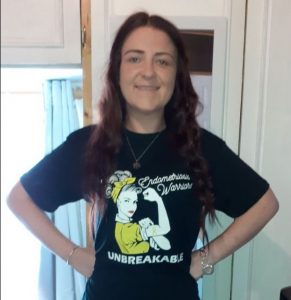
Aimee got her first period when she was 11-years-old and within a couple of months the bleeding became unbearably heavy.
“I needed plastic sheets on top of tampons and pads, and nothing seemed to stop the horrendous bleeding,” she told Cannabis Health.
Her mother did not recognise the symptoms as her three older sisters had not suffered with their periods the same way – so she took her daughter to the GP to find out more.
For 10 years Aimee was prescribed a host of patches, pills and injections, but not given a correct diagnosis.
When she turned 21 she was finally offered a laparoscopy, during which she was diagnosed with endometriosis and some of the offending cells were scraped away.
She was delighted to finally know what was wrong: “All I knew was, I wasn’t crazy. I do have something wrong with me.”
However, the pain continued and Aimee was referred to a specialist. Three years later she had a second surgery which still did not reduce the pain, and she found herself bed-bound.
Through desperation she travelled abroad to Romania for surgery, which found that the endometriosis had spread to her diaphragm, ovaries and pelvis. She is now on medication to stop her periods and reduce some of the associated pain.
Aimee had used cannabis recreationally but not considered its pain relieving effects until her mid 20s when she stopped using alcohol to self-medicate.
She has come up against some barriers however, as she does not meet the Irish Medical Cannabis Access Programme criteria for a medical cannabis prescription.
“My goal is to have cannabis removed from the Misuse of Drugs Act,” she said. “Because as long as it’s there… we don’t have any opportunities for research.”
She added that a freer cannabis industry could support farmers, cut social welfare costs and reduce stigma.
Aimee’s final thoughts?
I wish people would open their minds and try to empathise or understand someone else’s reasoning for their choices and medication.
Soph, 26, UK

Soph is a great supporter of natural methods of pain relief and was glad to find that cannabis allowed her to medicate naturally against the pains of endometriosis. She has become fascinated by the plant’s numerous medical uses and has spent a lot of time researching it over the years.
“I absolutely love it. It’s so interesting how it can impact people’s lives,” she told Cannabis Health.
“I’m so passionate about it because it makes me sad that people are using all the things that are having detrimental effects elsewhere in the body.”
Soph, who has been diagnosed with endometriosis, is not using any prescribed medication, only supplementing the cannabis with other natural remedies such as magnesium, Omega 3 and 6 and other foods with anti-inflammatory properties.
She finds cannabis helps with her pain, improves her appetite and allows her to have a restful night’s sleep.
As a strong supporter of medicinal cannabis, she is happy to talk to her family about it, but she still experiences some stigma and avoids conversations on the topic with colleagues.
She also says that many people are uneducated about endometriosis and do not understand the extent of pain that a sufferer often has to endure.
In the mornings she can often feel sick, dizzy and experience brain fog making it difficult to do everything she wants to.
“Sometimes I feel like I’ve literally got sandbags attached to my waist, dragging me down,” added Soph.
“People just don’t understand how you can look totally fine and still be living with a chronic invisible illness.”
Soph’s final thoughts? I wish people would realise that having to put on a brave face every day is difficult, especially when your body is attacking itself.
KJ, 25, UK
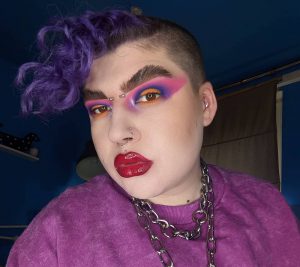
KJ has had a different experience of endometriosis as a non-binary person suffering from what is commonly thought of as a female condition.
They spent their teenage years not only struggling with their gender identity but also with immense amounts of pain and discomfort caused by the disorder.
KJ’s periods started when they were 10-years-old, and the pain got progressively worse each month.
At 15, they began to take a contraceptive pill which somewhat dulled the pain. But it was not until KJ was 17 when they began to experiment with cannabis, that they got some real pain relief.
“It was finally something that helps with the pain,” said KJ, who found it also helped them to eat and sleep.
“There’s no pain relief that’s ever helped me apart from cannabis.”
KJ was diagnosed with endometriosis about six years after their first visit to the GP.
But as a non-binary person, KJ explained that there are certain places – particularly on the internet – that they will avoid talking about their condition due to lack of understanding.
KJ has also experienced discrimination from clinicians, they said, especially when it comes to talking about having a hysterectomy, which they had to fight for.
“Getting clinicians to actually listen has been really hard. Every time I went to a new appointment, it was almost like I was going one step forward, five back,” they said.
KJ’s final thoughts?
Endometriosis is not just a cis, straight woman’s disease.
*Some names have been changed
Home » Advocacy » Living with endometriosis – how medical cannabis is dulling the pain

 News6 months ago
News6 months ago
 Science5 months ago
Science5 months ago
 Industry6 months ago
Industry6 months ago
 News6 months ago
News6 months ago
 News5 months ago
News5 months ago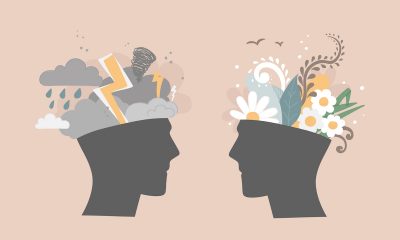
 Health4 months ago
Health4 months ago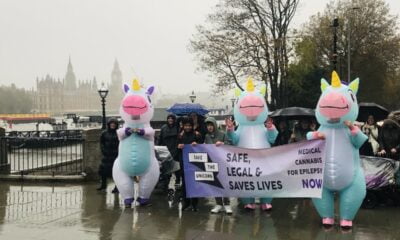
 News5 months ago
News5 months ago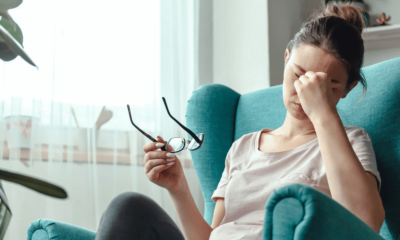
 Health3 months ago
Health3 months ago













